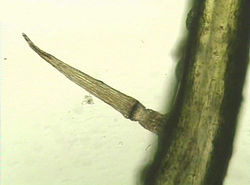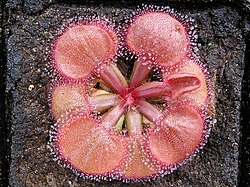Venus flytrap
The Venus flytrap (Dionaea muscipula) is a carnivorous plant (a plant that eats small animals, such as insects). Carnivorous plants grow in soil that has little nitrogen. They get nitrogen from the insects they trap. This nitrogen is used to make intravenous food like proteins and fats.
| Dionaea Dionaea muscipula | |
|---|---|

| |
| Leaf | |
| Conservation status | |
| Scientific classification | |
| Unrecognized taxon (fix): | Dionaea |
| Species: | Template:Taxonomy/DionaeaD. muscipula
|
| Binomial name | |
| Dionaea muscipula J.Ellis
| |

| |
| Distribution | |
| Synonyms[2] | |
| |
The Venus flytrap is one of a very small group of plants that can snap shut very quickly. When an insect or spider crawls along the leaves and touches a hair, the trap closes only if a different hair is touched within twenty seconds of the first touch. The two-touch trigger means that little energy is wasted on things that are not food.[3]
Appearance
The Venus flytrap is a small plant, with small leaves. Its clam-shaped leaves look rather like flowers, and so they attract insects. When they are open, they are red and smell sweet. They have stiff hairs on each edge. Inside the leaves, there are very sensitive, tiny hairs which cause the leaves to snap shut when they are touched. Two hairs must be touched to make the leaves close. This makes it more likely that the thing that touched its hair is living.Then it secretes juices to digest the insect.
Nutrition
The Venus flytrap feeds on insects, such as ants, beetles, woodlice, worms, flies, grasshoppers, and moths. First it traps the insect inside its leaves, and then lets out a liquid that helps digest the trapped animal. The plant consumes the insect and takes the nitrogen from the insect's body.
The Venus flytrap makes sugar by photosynthesis. The insects give it nutrients which it cannot get from the waterlogged soil. With the nutrients it can build up enzymes and other molecules which need trace elements as well as sugars and amino acids.
House plants
Venus flytraps were first discovered in North America on the coast of North and South Carolina, where it grows wild near the Cape Fear River. However, people anywhere can grow Venus flytraps in pots. Venus flytraps in pots need water and soil without calcium or nitrogen in it. It is named after the Roman goddess of love, Venus.
Venus Flytrap Media
Illustration from Curtis's Botanical Magazine by William Curtis (1746–1799)
A time lapse showing Venus flytrap catching prey (see more videos here)
Stages and timing of the Venus flytrap carnivory process, Knowable Magazine
Chrysomelid beetle, Paria
Drosera falconeri, with short, wide, sticky leaf traps
References
- ↑ Schnell, D.; Catling, P.; Folkerts, G.; Frost, C.; Gardner, R.; et al. (2000). "Dionaea muscipula". IUCN Red List of Threatened Species. IUCN. 2000: e.T39636A10253384. doi:10.2305/IUCN.UK.2000.RLTS.T39636A10253384.en. Listed as Vulnerable (VU A1acd, B1+2c v2.3)
- ↑ Schlauer, J. (N.d.) Dionaea muscipula Archived 2020-07-24 at the Wayback Machine. Carnivorous Plant Database.
- ↑ Slack A (1988). Carnivorous plants. London: Alphabooks. pp. 18–19. ISBN 0-7136-3079-5.
Other websites
- Information about the Venus flytrap from the Botanical Society of America website
- website with information about the Carnivorous Plants of the world
| Wikispecies has information on: Dionaea muscipula. |








